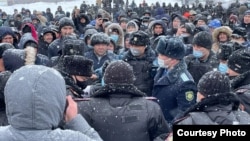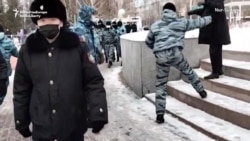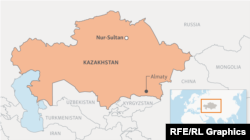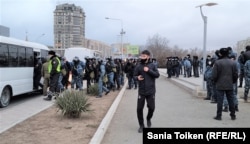When drivers in western Kazakhstan found out on New Year's Day that the cost of filling their gas tank had doubled, they got out of their cars and started protesting.
The drastic price increase in Zhanaozen for liquefied petroleum gas (LPG) -- which is used by many as a cheap alternative to gas -- sparked a movement that has brought people out to demonstrate across the country in support of the Zhanaozen protesters.
Kazakhstan’s government has already taken measures to lower the price of the propane-butane mixture in Zhanaozen, but problems over inflating prices have been building in western Kazakhstan generally -- and Zhanaozen, specifically -- for months.
Zhanaozen is an oil-worker town that has grown in recent years to some 160,000 residents as part of the energy boom in Kazakhstan.
It was in that city where at least 16 demonstrators were shot dead by police on December 16, 2011, after months of strikes and protests by employees of Kazakhstan’s oil sector.
It remains one of the worst incidents of violence in Kazakhstan’s 30-year history and Kazakh authorities have been careful in dealing with workers in western Kazakhstan ever since the killings.
Protesters who demonstrated on New Year's Day said the price of one liter of LPG in Zhanaozen was some 50 tenge for much of 2021, but started rising toward the end of the year to somewhere around 79-80 tenge (about $0.19), then jumped to 120 tenge (about $0.27) on January 1, 2022.
Abbat Urisbaev is a member of the provincial "maslikhat" (council) in Mangystau, where Zhanaozen is located.
Urisbaev said the increase is painful since “90 percent of the residents of our province use [vehicles] that use liquefied gas.”
Dozens of more people came out into the streets of Zhanaozen on the afternoon of January 2, and by evening there were reportedly several hundred blocking roads and demanding an immediate reduction in the price of LPG.
A group of the protesters posted a video message to Mangystau Governor Nurlan Nogaev and President Qasym-Zhomart Toqaev calling for the price to be lowered.
People in other towns in Mangystau -- Akshukyr, Shetpe, Kyzyl Tobe, Fort Shevchenko, and Tyshchybek -- posted videos of support for the protesters.
People in the towns of Kuryk and Zhetybay also demonstrated in support of those in Zhanaozen.
In the neighboring Atyrau Province, veteran activist Maks Bokaev -- who was released from prison in 2021 after being put there for his role in the 2016 protests against land reform -- also turned out on a main square in the city of Atyrau.
On January 3, several dozen Zhanaozen protesters who spent the night outside to continue the protest were joined again by hundreds of people. Many in the Caspian coastal city of Aqtau also demonstrated in support of the Zhanaozen protesters.
And some 100 people turned out in the city of Aqtobe to show their solidarity.
Some, including Nurzhan Altaev and members of his unregistered El Tiregi (National Reliance) party, demonstrated in the capital, Nur-Sultan.
The leader of the unregistered Democratic Party of Kazakhstan, Zhanbolat Mamai, led several dozen supporters to a rally in Almaty, where some 20 people were reportedly detained.
Police in Nur-Sultan, Almaty, and in the southern city of Shymkent gathered near city squares to prevent rallies in support of the Zhanaozen protesters.
Problems accessing the Internet were also reported in all three cities, with Telegram, WhatsApp, and Messenger being unavailable in the evening.
'We're Tired Of Fairy Tales!'
By the evening of January 3, Prime Minister Askar Mamin’s office released a statement that said all gas stations in Mangystau Province had been ordered to lower the price of LPG from 120 tenge to 85-90 tenge per liter and a government commission had been formed to look into the socioeconomic situation in the region.
Authorities have been using such tactics for many months and it was therefore not surprising that hundreds of protesters in Aqtau continued their rally at a main city square late into the evening of January 3, even setting up a large yurt to emphasis they did not intend to leave.
Nogaev, who was appointed Mangystau governor in September 2021 after serving as energy minister for two years, went to the square and repeated to the crowd Mamin’s orders on reducing the cost of LPG.
But the crowd chased Nogaev from the square shouting things such as “We don’t need a governor who can’t solve problems. Get out! We’re tired of fairy tales.”
That same night, dozens of people in the northwestern city of Oral demonstrated and called for LPG prices to be reduced to 50 tenge per liter. The number grew into the hundreds, and they attempted to block the road.
By the afternoon of January 4, the number of protesters in Oral had grown to some 500 and many were questioning why a commission was formed only to resolve economic problems in Mangystau and not in other provinces.
By the early evening, authorities announced the price for LPG in Mangystau would be reduced to 50 tenge per liter.
But detentions of activists and people trying to demonstrate were being reported on January 4 in Nur-Sultan, Almaty, Shymkent, Taraz, and other cities, while the websites KazTAG and Orda.kz -- which had been reporting on the protests -- were blocked.
There were more labor strikes in Kazakhstan in 2021 than there had been in the three previous years combined as noted in an article in The Diplomat and on the Oxus Society’s Central Asia protest tracker.
Most of the strikes in 2021 happened in Mangystau Province and many of them took place in Zhanaozen.
It was most often oil workers or employees in associated industries who went on strike, but health-care and public-transportation workers also temporarily stopped working until their demands were met.
They always sought more pay and better working conditions and while they never received all they wanted, they usually got some concessions from management or state authorities.
Some protesters have been calling for the price of LPG to be around 50 tenge per liter, but authorities initially seemed unwilling to drop the price so low.
The Kazakh Energy Ministry has already said the price of LPG is based on the commodity exchange.
“Switching to e-commerce allows the gas price to be balanced based on supply and demand,” the ministry said in a January 2 statement.
Berdibek Kartbaev, the head of Mangystau’s Department of Energy, Housing, and Communal Services, said the “previous price of some 60 tenge [per liter] won’t return…” since the cost of producing LPG was now some 70 to 85 tenge per liter and then there were additional operational and transportation costs.
Kartbaev said the average cost of one liter of LPG in Kazakhstan is currently about 110 tenge.
Olzhas Baidildinov, a freelance adviser to Kazakhstan’s Energy Ministry was even more blunt.
In an article for inbusiness.kz, Baidildinov also referred to the average price of LPG for Kazakhstan and questioned why any exceptions should be made for people in Zhanaozen.
Baidildinov said the average monthly wage in Kazakhstan was a bit more than 250,000 tenge (about $575) and claimed the “average wage in Mangystau in the third quarter of 2021 was 346,542 ($797) tenge,” while in Zhanaozen it was 505,000 tenge ($1,160).
“In Zhanaozen they are receiving twice more than the average wage in the country, but they want to pay half as much as everyone else in Kazakhstan,” Baidildinov wrote.
Cutting Across Society
During the 2021 labor strikes in Mangystau, workers were claiming they made much less than 505,000 tenge per month, in some cases less than 100,000 tenge, and many of them are at sites where toxic chemicals are present and they wanted extra pay for the hazardous conditions at their worksites.
Mangystau is also mainly desert and almost everything, including water, needs to be brought to the towns and cities in the interior, making the prices higher due to the transportation costs.
Because the current protest is not confined to a single industry or group of industries, it is already more problematic for Kazakh authorities.
The demand for lower LPG prices cuts across society and not only in the western parts of Kazakhstan.
And there are already signs that the economic problems that spark unrest are turning into political protests that Kazakh authorities especially want to avoid.
An early example of this was Nogaev being chased from the square in Aqtau.
Some of the protesters in Zhanaozen were calling for the people to have the right to elect their local leaders and, in July 2021 when oil workers were on strike, a group of deputies from the pro-government Nur Otan and Ak Zhol parties came to speak with the group.
They told them, “We are deputies whom you elected,” to which the striking workers replied, “You were named to your posts; the people did not elect you.”
If the price of LPG is really somewhere around 110 or 120 tenge per liter, Kazakh authorities will be hard-pressed to lower prices and with the number of labor strikes growing there are questions about how many concessions management and the government can make and what will happen when the answer to demands is finally "no."

















